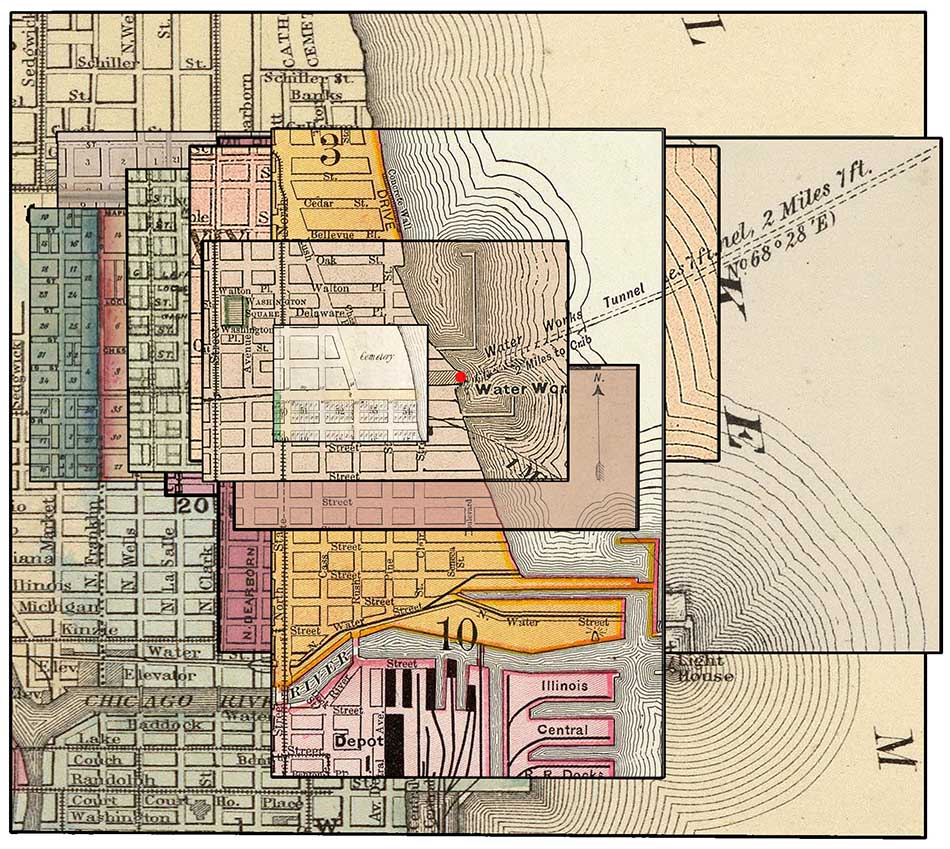The Museum of Contemporary Art recently opened the intellectual blockbuster, The Way of the Shovel: Art as Archaeology this week. The show, curated by Dieter Roelstraete, is a historical survey of the early 2000s.
In light of the exhibit, local artist Pamela Bannos took on her own project: Bannos spent a year researching the underground and unusual facts about the MCA's history.
Bannos’s study has resulted in a bountiful website, called "Shifting Grounds: Museum of Contemporary Art in Chicago," and a four-part lecture series on the history of the museum’s location in Chicago.
As a prelude to the first lecture in her series—which starts Saturday, November 16, and runs roughly once per month through February, 2014—here are some of Bannos’s most interesting discoveries:
1. The Underground Tunnel
A 10,000-foot long, five-foot diameter tunnel, known as The Great Chicago Lake Tunnel, runs beneath the museum. The massive project, undertaken in the 1860s to bring clean, fresh lake water to the city, stretches from the Water Tower to the site of a former water crib two miles off shore in Lake Michigan. The marvel of engineering received extensive coverage in local papers and was depicted in an engraving in an 1867 issue of Harper's Magazine.
Launching the crib into the lake, which would eventually connect to the tunnel to supply water to the city, was a huge public spectacle watched by thousands. From The Chicago Journal in July of 1865:
At a few minutes past ten o’clock the structure glided into the water as gracefully as a swan, and floated therein, to the admiration of every body. Then cheers arose form the multitude – men huzzaed, ladies waved their handkerchiefs. A dozen steamers and tugs, all of which were freighted with people, simultaneously screamed a long note of welcome from their steam whistles, and thus the second great event in the history of the pure water enterprises of Chicago was celebrated.
The first "great event," of course, was the groundbreaking of the tunnel on shore, a little closer to the site of the MCA today.
2. The Foul Foundation
The MCA sits on a landfill of garbage. The museum of high culture, and its neighboring tony condos, were built atop a swampy lakefront site that, as far back as 1893, was known for its stench. As the Chicago Daily Tribune reported that summer, "it was entirely out of the question for people in that locality to open their windows during the last few warm days to get a breath of fresh air on account of the smell."
It took decades for things to change, starting with a new German Consul's complaint, upon his arrival in 1907, that he had to "suffer a most odious smell coming from the dumps northeast of Chestnut street." By 1910, something called the Report of the Submerged and Shore Lands Legislative Investigating Committee had photographic evidence that the dump was finally being filled in.
3. The Panned Kahlo Show
Frida Kahlo had her first U.S. solo museum exhibition at the MCA. It was 1978, and nearly twenty years after the pioneering Mexican painter died, that an American museum finally validated her work with a retrospective. Unfortunately, the Tribune’s art critic, Alan Artner, belittled the show.
The review, excerpted in part on Bannos's site, is really quite shocking in light of how highly Kahlo's work is regarded today:
Kahlo led the kind of life that makes for a Ms. Magazine version of the romantic agony … All of this shows up in her art, though after several miscarriages and medically ordered abortions, her primary subject became pain… Keeping in mind that Kahlo’s works were created in a climate that was truly repressive to women, one can only marvel at the courage with which she presented all manner of grisly feminine experience. Yet, while her consciously naïve style depicts these horrors with uncommon directness, her psychological makeup was so intensely self-oriented that she was never capable of pulling back far enough to make a more general statement. By the time Kahlo begins painting herself in necklaces of thorns or with nails and arrows piercing her skin, one realizes that this has become an art of monumental self-pity—an art that will satisfy none by the most caterwauling feminist.
4. The Playboy Connection
When the MCA needed to find a building for its new venture, it just so happened that a building in use by the Playboy corporation was coming onto the market. From Bannos's research:
At the beginning of 1966, a one-story brick structure with a full basement, then in use by the Playboy Corporation, was found to be an ideal choice. Located on East Ontario Street, within the Chicago gallery district, the 18,000 square foot open-span space suited the Gallery of Contemporary Art's first needs. Hugh Hefner's lease was up in November, and the building's lease was signed over to the new art supporters.
Hugh Hefner himself also donated a considerable sum to the fledgling institution. An original typewritten summary of the MCA's activities from June 1966 to January 1967 lists, among its bullet points, "obtaining a $50,000 contribution from Hefner. Later, Hugh Hefner gave $150,000 (equivalent to ~$1million in 2013) as the museum's single largest gift. The Hugh M. Hefner foundation continues to be a supporter of the museum.
Nov. 16 at the Musuem of Contemporary Art, 220 E. Chicago Ave, mcachicago.org; Free with museum admission



